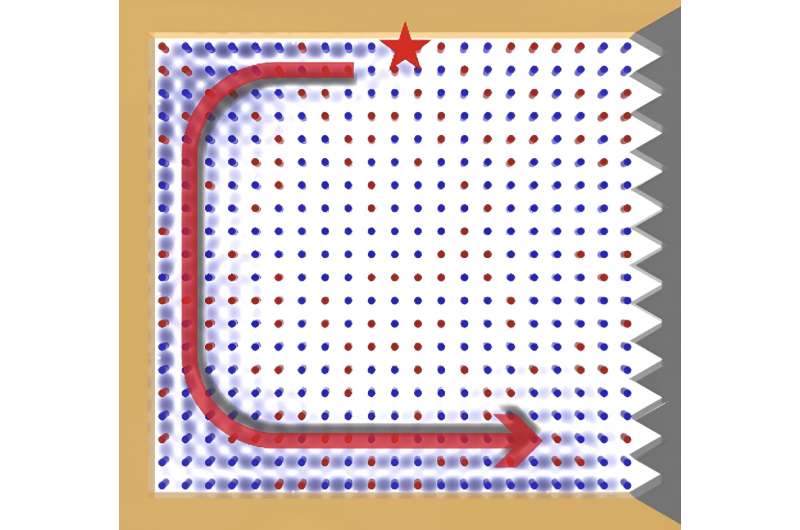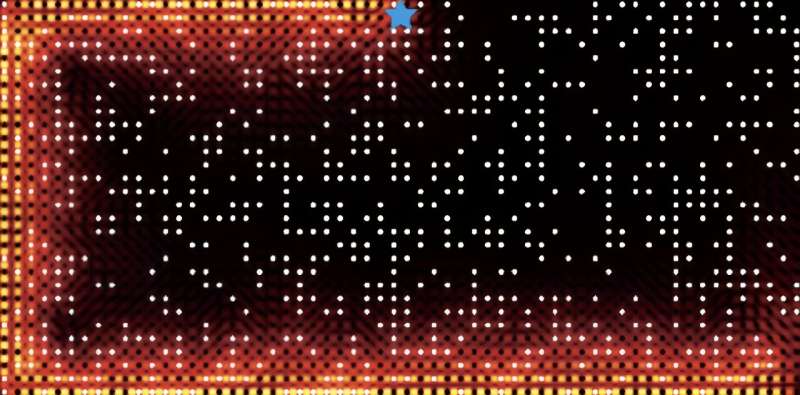
Schematic diagram of a topological photonic alloy. The red star indicates the position of the line source, and the arrow indicates the propagation direction of the chiral edge state. Credit: Qu et al.
Photonic junctions, alloy-like materials that combine two or more photonic crystals, are promising candidates for developing structures that control the propagation of electromagnetic waves, also known as waveguides. Despite their potential, these materials typically reflect light in the direction it originated.
This phenomenon, known as light scattering, limits the transmission of data and energy, negatively affecting the performance of materials as waveguides. The reliable reduction or prevention of light scattering in photonic junctions will thus be a milestone towards the practical use of these materials.
Researchers at Shanxi University and the Hong Kong University of Science and Technology have recently fabricated a new photonic alloy with topological properties that enable the propagation of microwaves without light scattering. This material, presented in Physical review papersmay pave the way for the development of new topological photonic crystals.
“Our work introduces a new concept: topological photonic alloy as a non-periodic topological material,” Lei Zhang, co-author of the paper, told Phys.org. “We achieved this by combining unmagnetized and magnetized rods in a nonperiodic 2D photonic crystal configuration. This created photonic couplings that support chiral edge states in the microwave regime.”
The main objective of the latest study by Zhang and his colleagues was to develop a new photonic alloy that exhibited a topological edge state, taking inspiration from the unique physical properties of the alloys. The researchers created their material by randomly mixing yttrium iron garnet (YIG) rods and magnetized YIG rods composed of substitutional or interstitial bonds.

Distribution of Chiral Edge States in Topological Photonic Alloy. The white dots indicate the positions of the unmagnetized YIG rods, the black dots indicate the positions of the magnetized YIG rods, and the blue star indicates the position of the line source. Credit: Qu et al.
“In our experimental setup, a vector network analyzer is used to establish connections between the source and probe antennas,” Zhang explained. “The source antenna is fixed in a specific position within the sample, while the position of the probe antenna changes to collect valuable information about the intensity and phase of the electromagnetic waves. To facilitate this process, circular holes are present in a metal plate through which both antennas are inserted.”
Zhang and his colleagues used a metal coating that served as a “topologically trivial material,” with a Chern number of zero. When this coating covers a topological photonic insulator with a Chern number of 1, a topological edge state appears at their boundary, in accordance with the large edge correspondence principle.
“The microwave damper in this structure is to suppress the transmission of boundary states,” Zhang said. “By using the absorber, we prevent the formation of a closed loop within the entire boundary condition, which can interfere with the accurate characterization of non-reciprocal phenomena.”
Experiments conducted by this team of researchers showed that their topological photonic alloy even exhibits topological properties with a low doping concentration of magnetized rods without requiring order. This remarkable discovery may open new possibilities for the experimental realization of topological edge states, as it suggests that chiral edge states can be produced without breaking the time-varying symmetry along a crystal.
“In our future studies, we plan to explore multicomponent topological photonic alloy systems,” Zhang added. “Multicomponent systems possess a greater number of degrees of freedom, enabling the manipulation of various parameters and leading to a wider range of intriguing effects. In addition, we soon plan to explore the possibility of realizing similar phenomena at frequencies optics and establishing the relevance of these results for photonic applications would be very intriguing.”
Zhang and his colleagues hope to soon extend their recent findings to the optical domain. This would potentially open up new opportunities for manipulating light and developing innovative photonic devices.
More information:
Tiantao Qu et al, Topological photonic coupling, Physical review papers (2024). DOI: 10.1103/PhysRevLett.132.223802. ACTIvE arXiv: DOI: 10.48550/arxiv.2406.05168
© 2024 Science X Network
citation: Design of a photonic alloy with topological properties (2024, June 19) Retrieved June 20, 2024 from https://phys.org/news/2024-06-photonic-alloy-topological-properties.html
This document is subject to copyright. Except for any fair agreement for study or private research purposes, no part may be reproduced without written permission. The content is provided for informational purposes only.